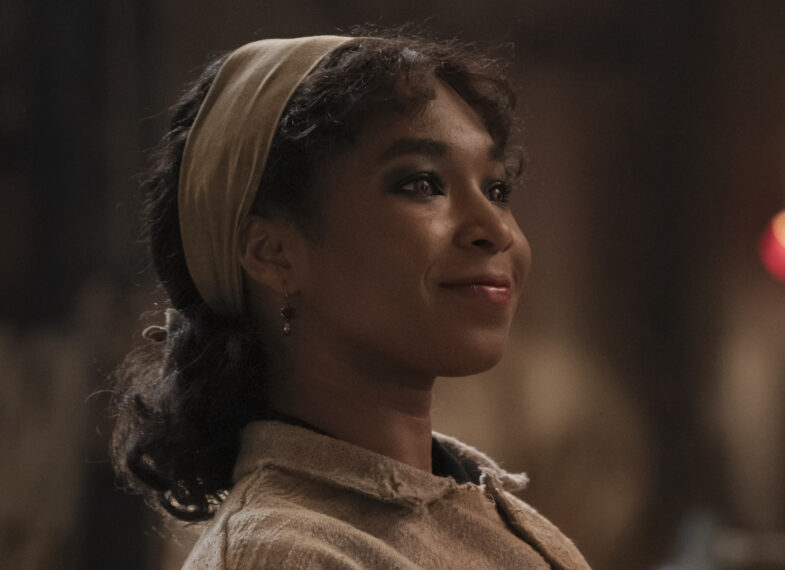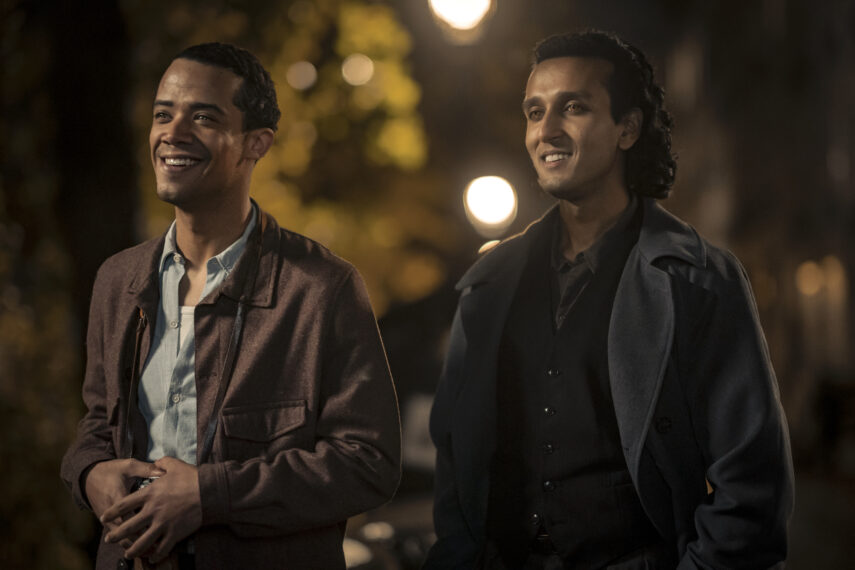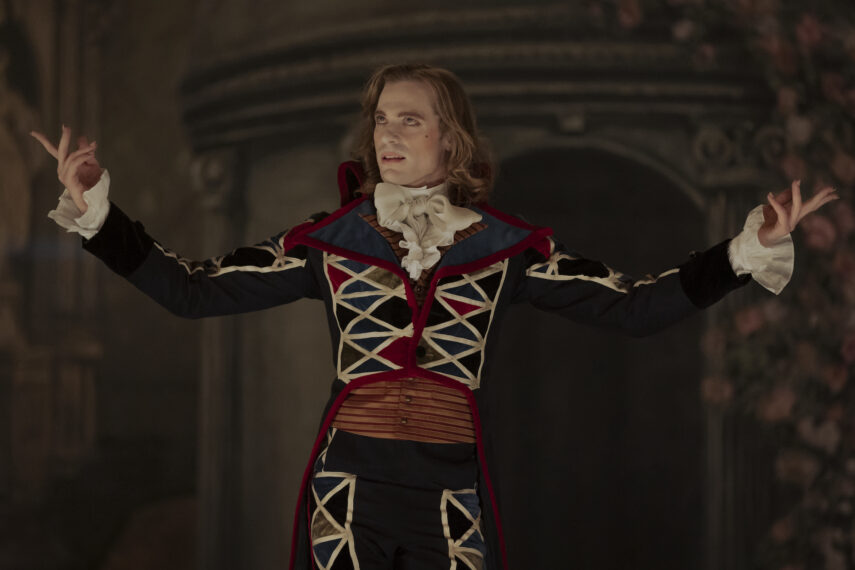When they become a vampire, they can’t change anymore [with] the length and the color of the hair and the facial hair, so we had to keep these details for the whole show. For example, even if it was in the ’40s, because most of [Season 2] is at the end of the ’40s, some [characters] came from the 18th century or some from Vietnam. So we had to match the past with the ’40s, and it was nice. The wigs helped me a lot.
Season 2 had shows within the show at the Théâtres des Vampires, so you had to design looks for the characters themselves in addition to the characters they played on stage. What were the challenges of that?
Vincenzo Mastrantonio: It was a challenge because we had to do a lot of makeup, and we changed them a lot for every character. And we had the people in the audience who wanted to be like them, so we had to also create the look for them that was close to the vampire look on stage. It was hard, but it was really nice, really nice to reach this result. I couldn’t believe it. I still can’t believe it. I watch it again, and it is really nice what we have done.
How did you settle on the mime aesthetic for the theater? And why do some members of the troupe have more white face paint than others for this look?
Mastrantonio: The musicians had to be more pale compared to the actors [to differentiate between their roles in the company], so we made them look not very, very white, but white. And after, we did some color on the eyes and they looked very good, they looked really nice. For Celeste and Estelle, the base that we had done there wasn’t so pale like the musicians. So we made them a little bit different, but after we added more color, more makeup according with the character that they had to do.
Santiago’s look is specially curated, with his bleach-blonde hair from before he became a vampire. Sam Reid joked that Santiago dyed it to look like Lestat. Can you expand on the inspiration for this design?
Pegoretti: We found some photos of a famous actor in the beginning of 20th century, Laurence Olivier. In the ’20s, he was blonde too. We decided to make [Santiago] as a famous actor who became a vampire around the ’20s of the 20th century, so he was very posh and elegant. We found this reference with Laurence Olivier and another few actors from London. They used to bleach the hair blonde, very blonde with this very fake makeup, so we decided with the actor and the showrunner [Rolin Jones] to make [Santiago] like that.
For Lestat, it’s different because [Reid’s] natural hair is a very beautiful blonde. I put just some extensions to make it nice and give more volume to him. The blonde is different because it’s natural and a real blonde as an elegant man from the 18th century. We decided to adjust from the first season, with the showrunner, to change the length, to leave it a little bit longer because they found the length of the first season a little bit short.
Armand among the 1700s theater audience in Season 2 Episode 3, ‘No Pain’ (Larry Horricks / AMC)
Because the show is playing with memory so much, you can get away with changing the appearance of vampires who are frozen in their appearance. How did the concept of faulty memory factor into your designs?
Pegoretti: Even for Louis, we changed the haircut a tiny bit. Because we changed Claudia [Hayles took over the role from Bailey Bass in Season 2], at some point we decided to change some little details, to keep the main details, but we changed some things. We were lucky because 90 percent of the cast was new, and also it’s a different moment. The first season is around 1900, the beginning of the 20th century. [Season 2] is around after the Second World War, some in the 1970s. We also changed some in the contemporary moment during the [2022] interview. It was nice because we had to pass from different periods. It was interesting. Even for Santiago, we changed many things, because when he is on stage, it’s a different look. It depends on who he’s going to play on stage. Sometimes it’s messy, sometimes sweaty. We played a lot with him.
Mastrantonio: Sometimes with the mustache. Sometimes we changed the eyebrow a lot in every direction.
Pegoretti: And also with him, we put on him a fake wig when he is a judge during [Episode 7]. I have to say, the cast was very nice with us. We worked very well together with all of them, so we created together the characters. Because it was a long [process], we had a lot of different situations between the stage, outside the theater, and in the flashbacks too. We shot the Children of Darkness [scenes from Episode 3] in the 18th century when it was dirty. With Armand, with Celeste, it was dirty, ugly, a bit wild. And they become actors. They become more elegant, so we’d change the makeup.

Larry Horricks / AMC
Delainey made Claudia feel both familiar and new after taking over the role from Bailey. How did you work together to create that same feeling with her appearance? How did you blend the two Claudias?
Pegoretti: To be honest, at some point, we couldn’t care about the first season. We kept adjusting the length of the hair, but the situation was completely different because at the beginning [of Season 2] it’s during the war, into the dust, into the ground. She started very dirty. And also we can play with her because she changed the look for the theater when she’s an actress, so we made [her look like] a doll. But also, we had to change the character because it’s completely new when she arrived in Paris. She changed the shape of the hair because she wanted to be more elegant, more womanly, so she becomes a little more fancy. She was doing the waves in the hair, so we completely changed the shape and the texture of the hair. We tried just at the beginning to have some connection with the first episode, so to keep this natural hair, not so curly, but the story is completely different, so we had to change the texture completely and the shape of the head.
Claudia’s a grown woman trapped in a teenager’s body forever. In Season 2, she’s trying to externally show that she’s a woman to avoid childlike treatment. How did that inform her makeup design?
Mastrantonio: We changed her makeup a lot from the first episode because she wanted to be older than this age. We had to work a lot on the base. We worked a lot on what she did at the theater, the doll. It was a big effort to change a lot of things. We didn’t think about the first season because it was another person completely.
Louis’ hair is different in the ’40s, in the ’70s, and in 2022. Tell me about how you worked together to bring Louis to life in these different timelines.
Pegoretti: We changed the shape completely. In the ’40s, the wax Brilliantine was in use. It made the hair shine, pulled back, and very tight. So with the waves, we changed [his hair] completely for this moment. For me, it was beautiful. We kept his natural hair just for the ’70s. We twisted a bit for the contemporary [look]. I used, for him, the same textures, the same materials of real men of the ’40s. The shining wax, Brilliantine, was very famous. Everybody used it in the ’40s to make their hair flat and shiny.
We [styled Jacob’s] own hair and just changed the shape and the texture, never the length. He keeps the same length for all of the show because, as with the other vampires, they can’t change the length of their hair. In the ’40s, all the men used this wax to be shiny, to be flat, to pull it back. To be very perfect was typical of the ’40s, so we did this one for him in Paris to let [Louis] feel more comfortable on the street with the other people because [everybody’s hair] was flat like that. And then it was his natural texture and hair just for the ’70s. For the contemporary, we twisted it a bit with a sponge. We were just working on his hair. We never used a wig with him.

Larry Horricks / AMC
How did Lestat’s Harlequin look come together for Episode 3? And how did the fact that this is Lestat from Armand’s point of view play into the design?
Mastrantonio: The big change was in the 18th century. We made him look more pale and with the red on the cheeks and some work on the eyes. After that, the look was almost the same. We made his face a little bit paler compared to his natural [skin tone]. We did the cheeks, we did the lipstick. A little bit darker on the eyes. It wasn’t a big change. It was just a little bit more just to show Harlequin, because most of the [design] was [in] the costume. So for us, it had to be just a theatrical look.
Pegoretti: For me, I just played about with the ponytails sometimes because in the 18th century, they used the ponytails on the back a lot. We did it sometimes, but mostly he preferred to stay with the hair down. When we used this ponytail, I made it longer, more theatrical look for the theater. I made the hair very long with a big bow that I made for him. It was typical for the 18th century to make this big bow. I love it because we also saw him from the back on the stage with the audience in front of him. And also when he met Armand with the Children of the Darkness, I made [his hair] very clean and pulled back. It was in the 18th century, but it’s also very fashionable for now with models. They want to see the face and the hair pulled back with the bow with the typical ponytail from the 18th century. So we played a bit with [Lestat] too, but mostly we left the natural hair. We changed the texture with him as well when he was wet, when Louis has the vision of him dead with the blood and the scar on the neck [in Episode 1]. And so you saw him messy and sweaty, and sometimes he’s more elegant in the theater. We played with him as well.
What are you proudest of from your work on Season 2?
Pegoretti: The theater was a big challenge. For both theaters — even for the theater at the end of the 18th century with Lestat, because in that one, the crowd was so huge, so we had a lot of people. Even on stage, we had a lot of actors playing with him, and we had the Children of the Darkness as well. The theater in general was a big challenge because we had to create the main character. We changed these characters with a theatrical look, and so you have many different situations about the show [that the theater company was performing]. So I’m very proud about the stage, about the theater, this world that we created because also it was a first for me. I’ve never done something like that before. I’ve never had any chance to create a theater of vampires in Paris in this beautiful world after the Second World War. I’m very proud about that. I think the world of the theater between the 18th century and the 1900s was great. I’m very happy about that.

Larry Horricks / AMC
Mastrantonio: The theater was the most beautiful thing for me to have done. I particularly enjoyed when we did Daciana [Diana Gheorghian] and Madeleine [Roxane Duran].
Pegoretti: That’s a great character.
Mastrantonio: There we had to work a lot. There we had to create something good with the wig, the makeup. And also we have seen scenes where all the military shaved the heads of the women, so we had to do the bald cap and the wig, a lot of things. But the most important, the most creative [element] has been, of course, the theater.
How cool to be able to create a theater environment in two different centuries of Paris.
Pegoretti: It was good because we had to change everything about the texture, about the fashion. It’s two completely different worlds between the centuries. Even the light is different. It’s candles for the first one and electricity for the second one. Even the palette and the colors is different with this. I like this dark theater for the Théâtres des Vampires of the ’40s. I think it was great. It’s also tricky because all of the makeup and hair is different than now, and so it’s more intense. It was also nice to create the fake wigs to put on the other wigs so that it looks real. So sometimes the actors wore two wigs on top [of each other], one for the main character, one for [another use, such as playing a character], so it was great. I’m very happy about that.
Interview With the Vampire, Seasons 1-2 Available Now, AMC+, Season 1 Streaming on Netflix

